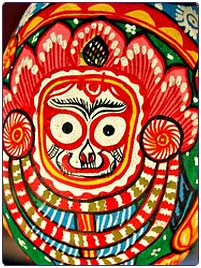A Carpenter for Krishna’s Chariot
By Kavitha Mandana | Feb 17, 2008

Every July in Orissa, outside a sleepy little town called Paradeep, everyone gets ready for the annual chariot (ratha) festival of Lord Jagannath. This town’s ratha traditions are entirely different from those followed by the more famous ratha at Puri, where only Hindus are allowed to participate and pull the chariot.
About one third of Paradeep’s citizens are Muslims, yet temple festivals are never a time for people to worry. In Paradeep, Muslims and Hindus have celebrated these festivals together for as long as anyone there can remember. Somehow every year each community seems to know what its duties are. The temple’s chariot had been built with timber donated by both Hindus and Muslims, and carved by both Hindu and Muslim carpenters. For the ratha yatra, Muslims clear the road and people of both communities pull the chariot’s sacred ropes.
Like the temple in Paradeep, the chariot is ancient and damages occur often. Ordinarily the town people immediately set about repairing the cart.
One year the problem was a little more involved. One of the intricately carved front panels, developed a crack right down the middle. This called for more than ordinary carpentry skills. It required a talented artist to carve a replica of the detailed forest scene on the cracked panel.
The temple priests thought about their options. Since the general feeling in Paradeep is that Lord Krishna’s chariot belongs to everyone, the carpenters of the village were summoned.
Since the annual festival was just a few months away, the temple authorities felt it was best to just seal the crack with some paste and varnish it to hide the crack. Looking for a master carver could be done after the festival. But the town’s carpenters weren’t happy with this idea. Lord Krishna couldn’t ride in a chariot with the front panel cracked, even if the crack was to be camouflaged!
The carpenters spent a couple of nights discussing the problem. They were honest about their talents and knew that there wasn’t a carpenter amongst them, Muslim or Hindu, who could carve that intricate forest scene. They considered searching for an artisan from another town to carve the panel for them. But somehow, nobody wanted an ‘outsider’ to work on their town’s precious chariot. How nice it would be if someone from their own area could fix the problem.
Finally they decided to choose the best carpenter from each community to jointly carve the new panel. This would be a trial. If the work didn’t look satisfactory enough for this year’s ratha festival, they’d follow the priest’s idea of temporarily sealing the crack. Then next year they would replace the panel.
For the moment everyone in town seemed happy. This had been a topic that was worriedly discussed in all homes, tea-shops and bazaars of Paradeep. Everyone was anxious about the situation except for the group of teenage boys who served tea near the temple. These sons of traders and sweet sellers knew a secret: they knew the extraordinary talent of Apu, a poor Christian boy who sometimes served tea with them for a daily wage.
Apu’s family was ‘new’ in Paradeep. They’d migrated from interior Orissa about 5-6 years ago, looking for work and fleeing villages where locals sometimes taunted them for converting to Christianity. As the family kept moving, Apu gave up his aspirations to become a carpenter. He sold away his precious tools, along with other household goods, when money was needed.
When Apu’s father had died, his family was forced to sell their small hut with a patch of land beside it to make ends meet, and Apu had taken up whatever job came his way, including selling tea during the busy festival nights. Very few knew that Apu had the most gifted pair of hands in the village. He could repair a leaking pipe, string a garland of flowers or carve a piece of wood like a magician.
Knowing this, his teenage friends begged him to show the few carved pieces he’d shyly revealed them to the temple priest. Apu refused. He said that the Muslim and Hindu carpenters that had already been selected were good craftsmen. For the first time in years, Apu’s family had felt safe. In Paradeep different religious communities seemed to coexist peacefully. He didn’t want to upset anyone by upstaging them and inviting their anger upon his family.
One busy night when Apu was busy running errands around the temple, some of his teenage friends snuck into his family’s home, stole all of his precious samples and ran off to show them to the priest. The old priest was delighted and, in turn, summoned the town’s best two carpenters to ask for their opinion. Both swore that the hand that had carved these beautiful samples had to carve a new panel for the ratha cart. Somehow, it didn’t matter to either the priest or the carpenters, that Apu was a Christian.
This is why one panel on the chariot looks so much better than the others. The town folk proudly point it out to visitors, as ‘Apu’s panel’. Since it’s Paradeep tradition that all work done for the temple is done for free, Apu didn’t get paid for his beautiful carvings; but Mohanty Babu offered him a job in his big carpentry shop. That’s how Apu could afford to send his younger brother back to school.















